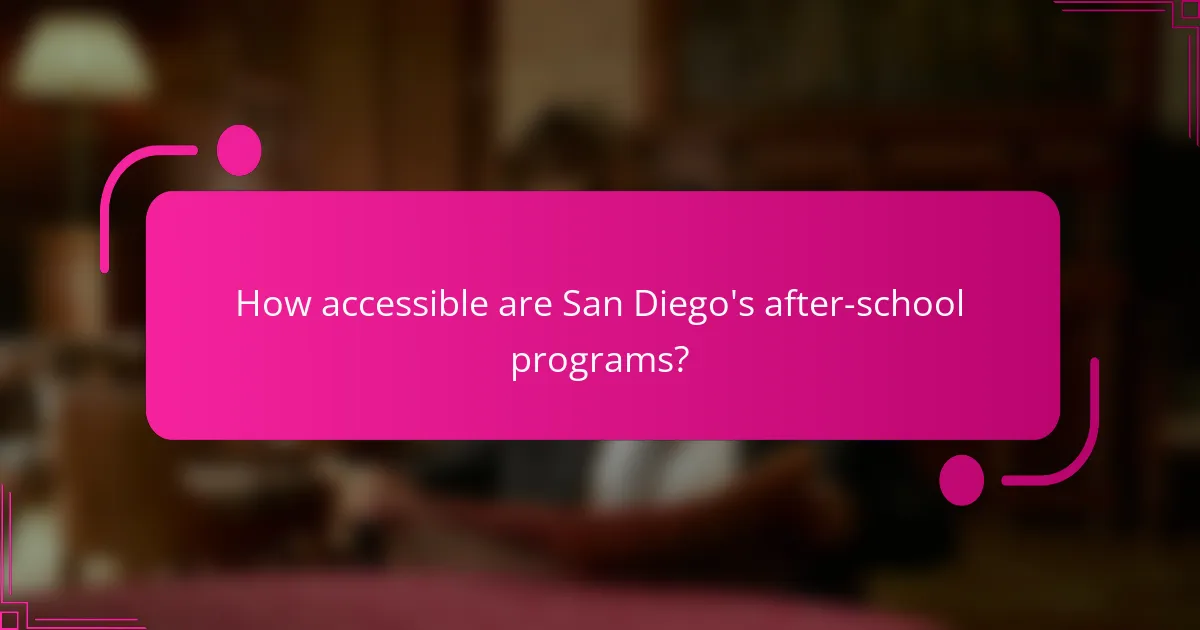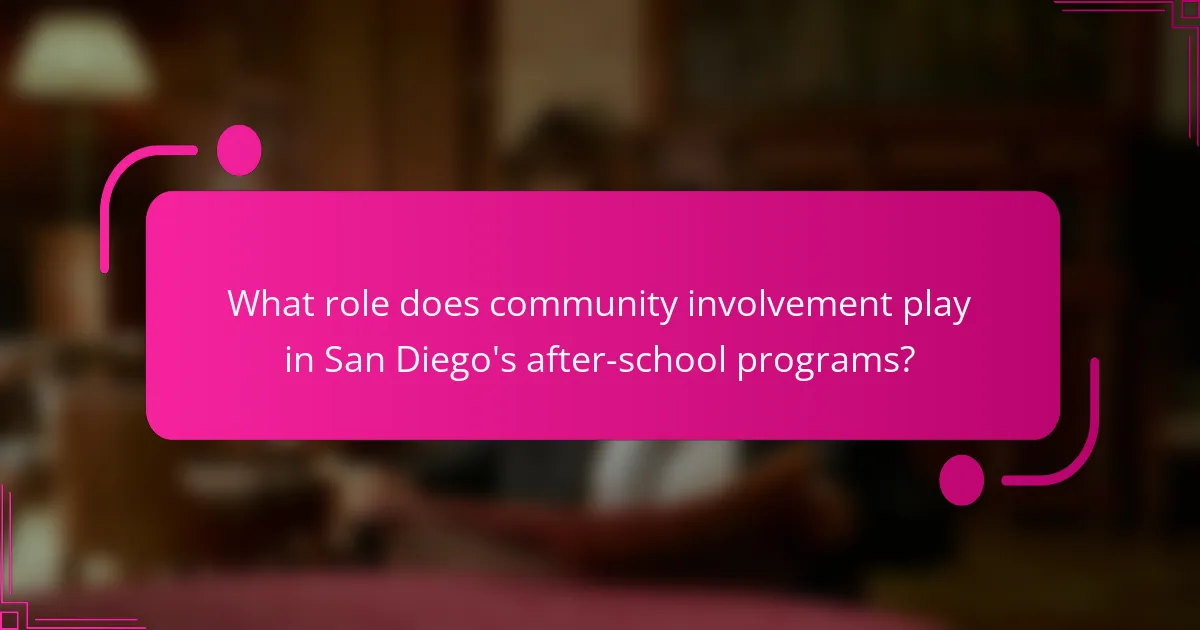
What are San Diego’s After-School Programs?
San Diego’s after-school programs are organized activities designed for students after regular school hours. These programs often include academic support, enrichment activities, and recreational opportunities. They aim to provide a safe environment for children while promoting learning and social skills. Many programs are offered by schools, community organizations, and local governments. According to the San Diego Unified School District, these programs serve thousands of students each year. They help reduce juvenile crime and improve academic performance. Access to these programs is often subsidized for low-income families, ensuring broader community involvement.
How do San Diego’s after-school programs operate?
San Diego’s after-school programs operate by providing structured activities for students after regular school hours. These programs typically run from the end of the school day until early evening. They offer a range of services, including homework assistance, recreational activities, and enrichment opportunities. The programs are designed to support academic achievement and promote social skills. Many after-school programs in San Diego are funded by local government, grants, and community organizations. They are often hosted in schools, community centers, and other accessible locations. Participation in these programs can enhance students’ learning experiences and foster community engagement. According to the San Diego Unified School District, these programs serve thousands of students annually, highlighting their importance in the community.
What types of activities are included in these programs?
San Diego’s after-school programs include a variety of activities. These activities often encompass academic support, such as tutoring and homework help. They also feature enrichment programs, which may include arts, music, and sports. Physical activities like team sports and fitness classes are common. Additionally, some programs offer STEM (science, technology, engineering, and mathematics) workshops. Social skills development activities, such as team-building exercises, are frequently included. These diverse activities aim to enhance student engagement and support overall development.
Who are the primary participants in these programs?
The primary participants in San Diego’s after-school programs are children and youth. These programs typically serve students ranging from elementary to high school age. Parents and guardians also play a vital role as they enroll their children in these activities. Additionally, educators and program staff facilitate the programs, providing guidance and support. Community organizations often collaborate to enhance the offerings available to participants. Local volunteers may also contribute their time and skills to enrich the program experience. Together, these groups create a supportive environment for youth development and learning.
What benefits do San Diego’s after-school programs provide?
San Diego’s after-school programs provide enhanced academic support and social development for students. These programs offer tutoring and homework assistance, which can improve students’ grades and understanding of subjects. They also foster social skills through group activities and teamwork. Participation in these programs has been linked to lower dropout rates. Additionally, after-school programs provide a safe environment for children during critical hours. Research shows that students involved in such programs are more likely to engage in positive behaviors. This engagement can lead to better mental health outcomes and reduced risk of delinquency. Overall, these benefits contribute to a more well-rounded educational experience for San Diego’s youth.
How do these programs support academic achievement?
These programs support academic achievement by providing structured learning environments after school. They offer homework assistance, tutoring, and enrichment activities that reinforce classroom learning. Research indicates that students participating in after-school programs show improved grades and test scores. For instance, a study by the Afterschool Alliance found that 75% of students in such programs improved their academic performance. Additionally, these programs foster a sense of belonging, which can enhance motivation and engagement in schoolwork. By addressing both academic and social needs, they create a holistic approach to student development.
What social skills do children develop through participation?
Children develop various social skills through participation in after-school programs. These skills include teamwork, as children learn to collaborate with peers on group activities. Communication skills improve as they engage in discussions and express their ideas. Conflict resolution abilities are enhanced when they navigate disagreements with others. Empathy is fostered as children interact with diverse groups and understand different perspectives. Leadership skills also emerge when they take initiative in activities. Research indicates that structured social interactions lead to better social outcomes in children. Programs that encourage participation significantly contribute to these skill developments.
How do after-school programs contribute to community cohesion?
After-school programs contribute to community cohesion by fostering relationships among families and children. These programs create a shared space for diverse community members to interact. They often include activities that promote teamwork and collaboration. This engagement helps build trust and understanding among participants. According to a study by the National AfterSchool Association, 75% of parents reported improved relationships with other families through these programs. Additionally, after-school programs often involve local organizations and businesses. This collaboration strengthens community ties and support networks. Overall, these programs serve as a catalyst for community involvement and unity.

How accessible are San Diego’s after-school programs?
San Diego’s after-school programs are generally accessible to students across various demographics. Many programs are offered at low or no cost to families. The city has initiatives aimed at increasing participation among underserved communities. According to the San Diego Unified School District, over 20,000 students participate in after-school programs annually. These programs are often located on school campuses, making them convenient for students. Additionally, transportation options are available for those who need them. However, some programs may have limited capacity, leading to waiting lists. Overall, accessibility varies by program and location within the city.
What factors influence the accessibility of these programs?
Factors influencing the accessibility of San Diego’s after-school programs include location, transportation, and funding. Programs located in high-need areas often serve more students. Transportation options can limit participation for families without reliable access. Funding availability affects the number of spots and resources for these programs. Community partnerships can enhance outreach and support. Additionally, language barriers may impact enrollment for non-English speaking families. These factors collectively determine how easily families can access after-school services.
How do transportation options affect program participation?
Transportation options significantly affect program participation by influencing accessibility for potential attendees. When transportation is readily available, more participants can attend programs consistently. Conversely, limited transportation options can create barriers, deterring families from enrolling their children. Studies show that programs with organized transportation see higher attendance rates. For example, a report by the National Center for Education Statistics indicates that students with reliable transportation are 30% more likely to participate in after-school programs. This correlation highlights the importance of addressing transportation challenges to enhance program accessibility and engagement.
What are the costs associated with enrolling in after-school programs?
Costs associated with enrolling in after-school programs vary widely. Generally, fees can range from $50 to $400 per month. Some programs offer sliding scale fees based on family income. Additional costs may include registration fees, materials, and activity fees. For example, some sports or specialized programs may charge extra for equipment. Financial aid or scholarships are often available to assist low-income families. According to the Afterschool Alliance, 10% of families report spending over $1,000 annually on after-school care. This highlights the financial commitment involved in securing after-school programs for children.
How do San Diego’s after-school programs cater to diverse needs?
San Diego’s after-school programs cater to diverse needs by offering a variety of activities tailored to different interests and age groups. These programs include academic support, arts, sports, and social-emotional learning. They are designed to engage students from various cultural and socioeconomic backgrounds. Many programs provide bilingual staff to assist non-English speaking families. Additionally, scholarships and sliding scale fees ensure affordability for low-income families. Partnerships with local organizations enhance resource availability. Data from the San Diego Unified School District shows increased participation rates among underrepresented students. This inclusivity helps foster a sense of belonging and community among participants.
What accommodations are available for children with special needs?
Accommodations for children with special needs include individualized education plans (IEPs) and tailored support services. These plans are designed to meet specific learning requirements. They may include modifications in the classroom, such as extended time on tests or alternative assignments. Additionally, support services may involve speech therapy, occupational therapy, or behavioral interventions. Schools often provide assistive technology to aid learning. These accommodations ensure that children can participate fully in after-school programs. According to the Individuals with Disabilities Education Act (IDEA), schools are required to provide these supports to eligible students. This legal framework ensures that children with special needs receive appropriate educational opportunities.
How do programs address the needs of different age groups?
Programs address the needs of different age groups by tailoring activities and support to their developmental stages. Younger children benefit from play-based learning and socialization opportunities. Programs for adolescents focus on skill-building and mentorship. Each program incorporates age-appropriate curriculum and resources. For instance, research shows that after-school programs can improve academic performance in elementary students. In contrast, high school programs often emphasize college readiness and career exploration. Feedback from participants helps refine offerings to meet specific age-related needs. This targeted approach ensures that all age groups receive relevant and effective support.

What role does community involvement play in San Diego’s after-school programs?
Community involvement plays a critical role in San Diego’s after-school programs. It enhances program effectiveness and sustainability. Local organizations, parents, and volunteers contribute resources and support. This collaboration leads to tailored programs that meet specific community needs. Research shows that engaged communities improve student outcomes. For example, programs with strong community ties report higher attendance and participation rates. Community involvement also fosters a sense of belonging among students. It encourages positive relationships and mentorship opportunities. Overall, active community participation strengthens the impact of after-school initiatives in San Diego.
How can local organizations support after-school initiatives?
Local organizations can support after-school initiatives by providing funding, resources, and volunteers. They can offer financial contributions to help sustain programs. This funding can be crucial for hiring staff and purchasing materials. Organizations can also donate supplies, such as educational materials and sports equipment. Additionally, they can engage employees as volunteers to assist in program delivery. Research shows that community involvement enhances program effectiveness and student engagement. For instance, a study by the Afterschool Alliance highlights that community partnerships lead to improved student outcomes. Local organizations play a vital role in enriching after-school experiences through these contributions.
What partnerships exist between schools and community groups?
Partnerships between schools and community groups include collaborations for after-school programs, mentorship initiatives, and resource sharing. Schools often partner with local nonprofits to provide after-school activities. Community organizations support academic tutoring and enrichment programs. These partnerships enhance student engagement and improve educational outcomes. For example, the San Diego Youth Services collaborates with schools for mental health support. Research shows that such collaborations lead to higher attendance rates and improved student performance. Community groups also provide resources like volunteers and funding for school events. These joint efforts create a supportive environment for students and families in the community.
How do volunteers contribute to the success of these programs?
Volunteers significantly enhance the success of San Diego’s after-school programs. They provide essential support through mentorship, tutoring, and organizing activities. Their involvement increases program capacity and reach, allowing more children to benefit. Volunteers often bring diverse skills and backgrounds, enriching the learning environment. Studies show that programs with volunteer participation report higher student engagement and improved outcomes. For example, a report from the National Afterschool Association highlights that volunteer-led initiatives lead to a 20% increase in student participation. This demonstrates that volunteers are vital to the effectiveness and sustainability of these programs.
What are the best practices for maximizing the impact of after-school programs?
Effective after-school programs should focus on structured activities that promote learning and engagement. Incorporating a mix of academic support, enrichment activities, and physical exercise is essential. Programs should also prioritize building relationships between staff and students. This connection fosters a supportive environment conducive to learning. Regular feedback from students and parents can help tailor the program to meet community needs. Research shows that well-designed after-school programs can improve student outcomes. For instance, the Afterschool Alliance reports that participants often show better attendance and academic performance. Engaging community partners can enhance resources and expertise. Collaboration with local organizations can provide additional learning opportunities. Finally, ensuring accessibility for all students is crucial for maximizing program impact.
How can parents engage effectively with after-school programs?
Parents can engage effectively with after-school programs by actively participating in program activities and maintaining open communication with staff. Regular attendance at program events fosters a sense of community. Parents should volunteer their time or skills to support activities. Engaging in discussions about their child’s progress helps staff tailor programs to individual needs. Providing feedback on program offerings can enhance the overall experience. Attending parent meetings keeps parents informed about changes and opportunities. Building relationships with other parents creates a supportive network. Research shows that parental involvement boosts children’s success in after-school programs.
What strategies can be implemented to enhance program quality?
To enhance program quality in San Diego’s after-school programs, implementing structured evaluation methods is essential. Regular assessments can identify strengths and weaknesses within the program. Engaging stakeholders, including parents and community members, fosters collaboration and ensures diverse perspectives. Professional development for staff improves teaching techniques and program delivery. Incorporating feedback mechanisms allows for continuous improvement based on participant experiences. Establishing partnerships with local organizations can provide additional resources and expertise. Data-driven decision-making enhances accountability and effectiveness. Research indicates that programs with these strategies show improved outcomes for participants.
San Diego’s after-school programs are organized activities designed to support students academically and socially after regular school hours. These programs offer a variety of services, including homework assistance, enrichment activities, and recreational opportunities, catering to children from elementary to high school age. The article outlines the benefits of these programs, such as improved academic performance and social skill development, while also addressing accessibility factors, community involvement, and the role of local organizations and volunteers. Additionally, it highlights best practices for maximizing program impact and strategies for parental engagement.